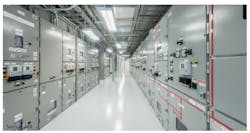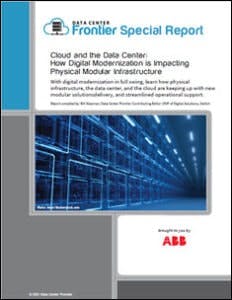Last week, we continued our special report series on how physical infrastructure, the data center, and the cloud are keeping up with new modular solutions delivery, and streamlined operational support. In our final article in the series, we’ll examine some solution architectures for scalable, modular data center designs.
Get the full report.
With the modular market developing in the industry, some tremendous innovation and engineering design efforts have been put into solutions. The modular market is maturing, with even more large enterprises actively deploying the modular data center platform.
To that extent, there is already quite a bit of industry adoption as it relates to modular solutions:
- Large Internet companies and cloud providers were early adopters because they needed to optimize deployment at utility-scale implementations. They need to scale infrastructure quickly and easily, deploying thousands of servers at a time and optimizing both operations and financial aspects of those deployments.
- Federal agencies are facing mandates to improve IT efficiency and offer citizens greater transparency into their operations. The National Defense Authorization Act (NDAA) was signed into law with a section on data centers, the IT industry, and cloud- hosting providers (Section 2867). The NDAA states that moving forward, a modular approach must be included when deploying new data centers.
- The enterprise has come on board as the modular industry graduated out of its early phases and matured a product into a more attractive option.
Large enterprises have millions of square feet of data center space to manage and tremendous utility bills to match. - The finance industry has been seen as an early adopter of the modular approach. Financial firms typically have single-tenant facilities with vast quantities of square feet of traditional data center space across their portfolio. The opportunity exists to standardize components of the data center, move that unit of measure from the rack to a module, and take advantage of the power and cooling efficiencies available in modular solutions.
- Cloud, edge, data center, and hyperscale leaders are also getting into the modular mix. With massive growth around digital requirements, leaders in infrastructure have struggled to ensure they deliver enough capacity to their market. Further, they won’t be wasting money or resources by over-building. A modular design ensures that the right resources are available and more can be added in a repeatable manner.
With all of this in mind, there are still some hesitations related to modular adoption. These ‘modular myths’ date back to the first generation of modular deployments. Let’s examine some of these myths and where today’s modular modernization and the race to data center ROI impact digital infrastructure.
Breaking Down Modular Myths and Improving ROI
Modular Myth #1: Modular solutions are too expensive.
MODULAR FACT
- Deferred Capital Cost: As a significant capital expense, building a data center is typically a large project that requires a lot of money upfront to anticipate forecasted IT needs for the next 10 to 15 years. Rapidly changing technology in the data center makes it difficult to justify such a considerable capital expense for a building that will hopefully keep pace with technology demands.
Modular solutions can be seen as intelligently applying capital to the data center in line with changing technology and IT requirements. Instead of a $50 million project on day one, ten $5 million modules can be built as they are needed. It enables the ability to add capacity to the data center incrementally.
- Operating Expense: The engineering in modular solutions has proven known efficiency throughout subsystems, allowing regular operational expenses to be optimized. Optimized power and cooling built-in to modules equate to a lower overall operating cost.
- Reduced Strain on Resource: Building for today’s requirement using modular build methods allows colocation providers to only invest an amount that will deliver a fast return via rapid uptake of server space and a timely generation of revenue. By breaking down the upfront investment into smaller chunks, revenues can be generated on each investment before the next modular expansion begins. This allows data centers to be more flexible in their response to market changes. Furthermore, installing a modular building block is faster and more efficient onsite, requiring fewer resources. In turn, this translates into lower risk and further time and cost savings.
- Modular Solutions are Classified Differently: Did you know that modular designs are considered equipment and not buildings? It’s important to consider how, potentially, this can impact your finances and how depreciation happens against equipment. Because modular architectures are considered equipment and not buildings, you could substantially positively impact ROI.
Modular Myth #2: Operations become more complicated.
MODULAR FACT
- Standardization: Seen as a part of the industrialization of data centers, the modular solution is a standardized approach to build a data center. Manufactured data center modules are constructed against a set model of components at a different location instead of the data center site. Standardized infrastructure within the modules enables standard operating procedures to be used universally. Since the module is prefabricated, the operational procedures are identical and can be packaged together with the modular solution to provide standardized documentation for subsystems within the module.
Here’s another critical point: you don’t have to worry about a lack of sub-contractors and trade professionals. Due to the nature of the design and standardized module architecture, you can have your equipment and facility up and running with minimal requirements for contractor support. The reason for this is that your equipment comes delivered as factory-built units. These modular units are pre-assembled, tested in a controlled factory environment, and delivered directly to the construction site. These efforts minimize the need for additional onsite construction and additional personnel.
- DCIM (Data Center Infrastructure Management) and Beyond: The module and components management within a modular approach can leverage the engineering and integration built into the product. Many, if not all of the modular products on the market will have DCIM or management software included that gives the operator visibility into every aspect of the module’s IT equipment, infrastructure, environmental conditions, and security. The other important factor is that distributed modular data centers will now also be easier to manage. With DCIM solutions now capable of spanning the cloud — data center administrators can have direct visibility into multiple modular data center environments. This also brings up the question of what’s next in data center management.
As the modular data center market matures and new technologies are introduced, data center administrators will need a new way to manage their infrastructure. There will be an immediate need to transform complex data center operations into simplified plug & play delivery models. This means lights-out automation, rapid infrastructure assembly, and even further simplified management. The next iteration of DCIM aims to work more closely with modular ecosystems to remove the many challenges which face administrators when it comes to creating a road map and building around efficiencies. In working with the future of DCIM, expect the following:
- An integrated end-to-end automated solution to help control a distributed modular data center design.
- Granular centralized management of a localized or distributed data center infrastructure.
- Real-time — proactive — environment monitoring, analysis, and data center optimization.
- DCIM that can be delivered as a self-service automation solution or provided as a managed service.
Modular Myth #3: Business and market alignment becomes more challenging with a new data center solution.
MODULAR FACT
- Rightsizing: Modular design ultimately enables an optimized delivery approach for matching IT needs. This ability to right-size infrastructure as IT needs grow enables enterprise alignment with IT and data center strategies. The module or container can also provide capacity when quickly required for projects or temporary capacity adjustments. Why is this important? Resources are expensive. Modular data centers can help right-size solutions so that resources are optimally utilized. Over or under-provisioning of data center resources can be extremely pricey — and difficult to correct.
- Supply Chain: Many of the attributes of a modular approach speak to implementing a supply chain process at the data center level. To optimize deployment, the IT manager directs vendors and controls costs throughout the supply chain.
Another critical consideration is working with a modular partner that can support a healthy supply chain. When working with modular designs, make sure you have a partner that can think locally and deliver globally.
When working with modular designs, make sure you have a partner that can think locally and deliver globally.
- Total Cost of Ownership
- Acquisition: Underutilized infrastructure due to over-building a data center facility is eliminated by efficient use of modules deployed as needed.
- Installation: Weeks and months instead of more than 12-36 months to stand up a traditional data center.
- Operations: Standardized components to support and modules are engineered for extreme efficiency.
- Maintenance: Standardized components enable universal maintenance programs.
Much like anything in the technology market, solutions continue to change and evolve. Many of the legacy perspectives on modular solutions revolve around an older generation of modular design. Today, modular data centers are more efficient, denser, and a lot easier to deploy. Let’s examine some solution architectures for scalable, modular data center designs.
Solution Architectures for Scalable Modular Data Center Design
To ensure your data center design is modular and scalable, it is essential to select scalable equipment. Switchgear, uninterruptible power supplies (UPS), power distribution units (PDU), and remote power panels (RPP) are all examples of scalable equipment. Get this right and specifying future expansions will be time and cost-efficient.
With this in mind, let’s look at some emerging Gen 2 Modular Design considerations.
- MV GIS Switchgear: Selecting medium voltage Gas Insulated Switchgear (GIS) that can be scaled up without emptying the gas from the system
makes scaling quicker and easier without disrupting service. Market-leading flexible switchgear designs can include a three-phase encapsulated, arc-resistant switchgear for single and double busbar applications with separate gas-filled busbar and circuit breaker compartments. Specifying equipment with plug-in technology enables safe, fast, and easy installation without the need for special tools. - UPS that’s built for flexibility: The UPS plays a vital role in ensuring clean and continuous power for the critical infrastructure. A modular UPS based on a decentralized parallel architecture (DPA) allows data center designers to scale the power on demand and lower upfront investment. Using the DPA design, every power module has its own fully independent entity, control, and required hardware for autonomous operation. A single point of failure is removed with DPA architecture, providing continuous uptime even during maintenance or system expansion.
- Power distribution units (PDU) and remote power panels (RPP): Power distribution units (PDUs) and remote power panels (RPPs) help meet the demands of power-intensive applications, delivering unsurpassed power monitoring and distribution in a safe, reliable, space-saving footprint. PDUs/RRPs can be configured as needed, and they are scalable regarding the number of outputs and required output power, ensuring continuous power to critical applications. Furthermore, market-leading systems of this nature can help panel builders dramatically reduce the cost of certification and facilitate easy post-installation alterations, such as the ability to change or extend the number of connected servers.
The Digitalization of Modular Infrastructure
Digitalization within the modular industry is a significant design consideration for Gen 2 modular designs. Systems of this nature are much more scalable because changes to the configuration can be done remotely using software, as opposed to changing out hardware or reassembling wiring.
IEC 61850 is a well-established communications standard for substation automation. The high reliability, integrated diagnostics, fine selectivity, shorter fault reaction times, and better fault tolerance delivered by IEC 61850 make it ideal for data center power infrastructure.
IEC 61850 AND MODULAR DATA CENTERS
The world is experiencing a data explosion. Not only is the quantity of data increasing at a dizzying rate, but the extent to which society relies on that data is also growing by the day. These trends elevate the data center to the status of critical infrastructure in many countries. If a data center fails, chaos ensues, which makes a reliable power supply indispensable. Generally, data centers have well-thought-out power backup provisions — such as uninterruptible power supplies (UPSs), diesel generators, etc. By employing IEC 61850-enabled devices and IEC 61850-based GOOSE (generic object-oriented substation event) communication to automate the data center power infrastructure, significant improvements can be made: better power supply reliability, greater operational control, and reduced cost, for example.
GEN 2 MODULAR CONCEPTS AND AUTOMATION
Working with the next iteration of modular data center design means eliminating wasteful processes and operations. In many cases, this means adopting new solutions around infrastructure automation.
IEC 61850 is eminently suited to data center power infrastructure automation. Using just one protocol can form the bedrock of a complete electrical design concept that includes the full protection, control and supervision system, and cybersecurity. By using optical fiber instead of copper wire, wiring costs are lowered, space requirements are substantially reduced, and safety is increased. IEC 61850 also delivers the capability to monitor and control IEDs remotely. The convenience is that devices supplied by different manufacturers can communicate with each other without custom-designed gateways or other engineering-intensive complications.
Taking a broader perspective, the IEC 61850 standard allows digitalization of the data center power system in a way that opens it to collaboration with other digital entities in the data center, such as a building management system (BMS), power management system (PMS), data center infrastructure management (DCIM) or ABB Ability™ Data Center Automation.
These are all essential parts of the final goal: the “single plane of glass” that orchestrates the entire data center. Decathlon for Data Centers, for instance, gives power and cooling visibility, and IEC 61850’s open protocols allow integration of existing equipment and systems. With IEC 61850 peer-to-peer communication capabilities in components like ABB’s Relion relays and Emax circuit breakers, one can go from the DCIM system controlling or supervising software to having real-time interaction with the subsystem (such as a UPS breaker) itself.
The IEC 61850 architecture is the ideal standard for data centers, as it delivers increased reliability, finer selectivity, shorter fault reaction times, and the possibility to implement fault tolerance and integrated diagnostics, as well as a host of other advantages.
Download the full report, “Cloud and the Data Center: How Digital Modernization is Impacting Physical Modular Infrastructure,” courtesy of ABB for two exclusive case studies and tips for getting started on the modular journey.
About the Author




